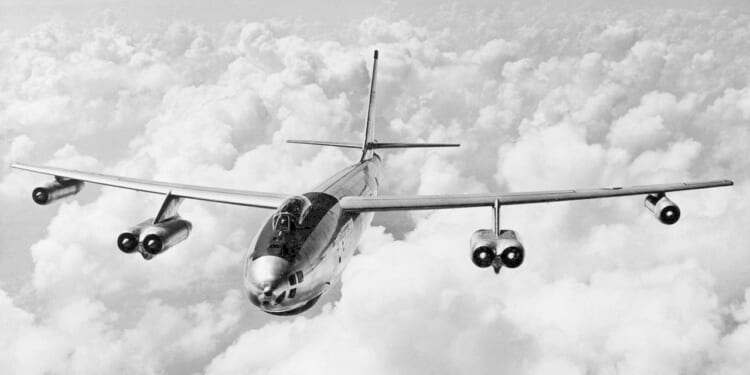The B-47 was so aerodynamically clean that generating the drag necessary to slow down and land safely required the use of drogue parachutes.
The B-47 Stratojet, a Cold War-era strategic bomber, certainly had one advantage over its contemporaries: good looks. With swept wings, a slender fuselage, and a bubble canopy, the B-47 looked almost more like a nimble fighter than a lumbering bomber. But indeed, the B-47 was a subsonic, long-range brute, designed to deliver a nuclear warhead to the heart of the Soviet Union.
Amidst the tensions of the Cold War, the B-47 was produced en masse, with over 2,000 units eventually joining the U.S. Air Force’s Strategic Air Command (SAC), reaching a peak in the late 1950s. By 1965, however, the B-47 was on its way out, with the more capable (and still-serving) B-52 Stratofortress becoming the preeminent bomber of the SAC.
Designing the B-47 Stratojet
The most distinct feature of the B-47, arguably, is the swept-wing design. The B-47 was in fact the first bomber ever to feature a swept wing. The idea originated in the ruins of Nazi Germany, where secret Nazi aeronautics laboratories were working on swept-wing concepts at war’s end. With the Nazis’ defeat, and the subsequent Allied raid of Nazi technical information, the swept-wing design was exported back to the U.S. in time for the crafting of Boeing’s new strategic bomber.
The wings of the B-47, which would be swept at 35 degrees, were shoulder-mounted, with inboard turbojet engines mounted in twin pods while the outboard engines were mounted as a single pod close to the wing tip. The six-engine configuration was also distinct—and more importantly, powerful; when the B-47 rolled off the assembly line in the late 1940s, the type was regarded as the fastest bomber in the world. The General Electric J35 turbojets offered about 3,970 pounds of thrust; however, early jet engines offered poor thrust at low speeds, so to assist in takeoffs when the bomber was fully loaded, solid fuel rocket assisted takeoff (RATO) rockets were occasionally used, with nine mounts near the rear of the fuselage. The RATO was capable of producing 1,000 pounds of thrust each.
Ironically, while the B-47 was slow on takeoffs, she was also fast on landings. Indeed, the B-47 was so aerodynamically clean that generating the drag necessary to slow down and land safely required the use of drogue parachutes.
The B-47’s Low Tolerance for Error Nearly Led to Disaster
And the B-47 had one more worrisome quirk: at higher altitudes, the wing didn’t generate much lift, creating a “coffin corner” flight envelope in which only five knots separated the stall speed and the maximum Mach speed. So, to keep the B-47 in stable flight at the altitudes within which she operated most efficiently, the pilots had to diligently maintain an air speed within five knots, lest the plane lose stable flight. The B-47’s massive fuel capacity complicated the task of staying within the five knot window; as the bomber’s 17,000 gallons of fuel burned off, the aircraft’s center of gravity could change drastically, requiring the copilot to make near constant adjustments accordingly.
In the end, the B-47 was never called upon to fulfill her design purpose: dropping a nuclear weapon on the Soviet Union. The B-47 did drop one nuclear bomb, however—near Tybee Island, off the coast of Savannah, Georgia, during a training mishap in 1958. The bomb was never found.
About the Author: Harrison Kass
Harrison Kass is a senior defense and national security writer with over 1,000 total pieces on issues involving global affairs. An attorney, pilot, guitarist, and minor pro hockey player, Harrison joined the US Air Force as a Pilot Trainee but was medically discharged. Harrison holds a BA from Lake Forest College, a JD from the University of Oregon, and an MA from New York University. Harrison listens to Dokken.
Image: Wikimedia Commons.
















